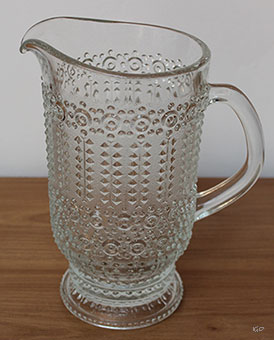 - Welcome - glass
- Welcome - glass
Working glass
Glass is a material made of sand, soda, and lime. It must be heated to a high temperature of more than 1000 degrees to reach a state of fusion.
Glass-blower
The glass-blower shapes the glowing material with his cane. This one was found engraved on Egyptian monuments and testifies to the former origin of this technique. This hollow tube allows him to blow air to shape the material far enough away from the heat.
He recovers the molten material and regularly applies rotational movements to obtain a perfectly centered object. He also uses the mallet for the unification and cooling of the glass. Dexterity comes after many hours of practice.
Blown glass ornaments
The glass ornaments used for Christmas were first made in the east of France, in Alsace, in the 18th century, and at the same time, Christmas trees were installed inside the house.
The Alsatian, driven by emigration after the war of 1870, exported this tradition all over the world, from Eastern countries to New York.
This know-how spawned decorative objects for Christmas, including a large diversity of baubles, bunches of grapes, birds of paradise, Saint Nicolas figurines, the infant Jesus, and even toy soldiers. This decorative work done delicately by hand has an incomparable charm.
Glass cutter
The glasses of the Cristalleries of Saint-Louis, located in northeastern France, are decorated and cut by hand. The crystal is made up of sand, lead, and potash.
The artisans intervene after the shaping of the glass. They work with a grindstone. The learning process begins with simple designs to finally work templates more sophisticated, a gesture repeated several times, for example, the “Diamond” cutting.
This decoration is engraved on Tommy glass, the flagship product of the Cristalleries de Saint-Louis. It was created in remembrance of British soldiers after the First World War.

Baccarat crystal in white filigree was created before 1850.
Bohemian glass
Bohemian crystal dates from the 15th century. Several companies are specialized in cutting, engraving, and colored glasses. Some manufacturers are dedicated to making carafes, chandeliers, amphorae, and plates.
Lined glass is a technique used by Bohemian glassmakers, with the superposition of layers of crystal.
St. Vitus Cathedral in Prague is adorned with a Bohemian glass mosaic on the theme of the Last Judgment. Pope Pius II evokes the magnificence of these stained glass windows in a book in Latin.

Bohemian glass in the Czech Republic.
Glassmaker
These craftsmen have an artistic sense and technical skills to produce these refined pieces by working with a glass heated.
The expertise of these glassmakers is essential in the tableware and the production of luxury bottles. The manufacture of these molds is now semi-automated, but the finishing stages are still done by hand.
These first glassmakers settled near a forest to easily feed the fire. Later, they moved in next to the railway lines to facilitate transportation and coal. It was the case in the glass valley, the Bresle valley, in Picardy Maritime. Famous perfumers were among their clients for the creation of luxurious bottles.
Stained glassmaker
The stained glass allows the light to radiate inside our cathedrals. This profession is as old as the construction of these monuments. Although technology has evolved, the know-how remains unchanged.
The craft consists of assembling fragments of colored glass with lead came in general. The color palette of the glass is quite wide, as well as its appearance, which allows for playing with brightness. The transparency can be more or less translucent, or opalescent, just as the texture can be more or less smooth or ribbed. The choice of colors and the assembly always depend on the talent of the stained glass artist.

"Saint Martin sharing his coat with the poor of Amiens" was made by Lucien Lobin, a master glassmaker.
In about 334, a Roman legionnaire named Martin, the future bishop of Tours
would have given half of his coat to a beggar shivering with cold in Amiens,
These soldiers owned half of their uniform, and the other half belonged to the state.
